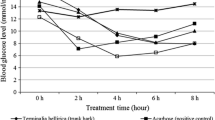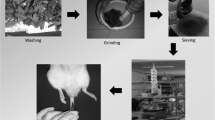Abstract
Various literatures recorded approximately 60 medicinal plants in Bangladesh that have antidiabetic properties. Of these medicinal plants, only 14–16 are found in traditional herbal markets and they are being randomly used to treat diabetes. Since diabetes mellitus increases reactive free radicals along with various complications in the body, antidiabetic plants that can potentially neutralize free radicals, may be of central interest to manage the disease. Present study compares functional bioactive components such as total phenolics, flavonoids, anthocyanins contents and antioxidant potential of methanol extracts of antidiabetic medicinal plants that are common in traditional herbal markets. Among the 14 extracts, Syzygium cumini was very rich in total polyphenol content (294 mg gallic acid equivalent, GAE/g) followed by Swertia chirata (183 mg GAE/g) and Ficus racemosa (bark) (154 mg GAE/g). These three extracts also had elevated amount of flavonoids and anthocyanins. S. cumini showed very high DPPH and NO free radical scavenging activities with IC50 of 6.25 and 48.61 μg/mL respectively followed by S. chirata and F. racemosa (bark). S. cumini also showed very high reducing power and total antioxidant capacity followed by S. chirata and F. racemosa (bark). In addition, the study revealed strong correlation between phenolics and reducing power (r = 0.94). Hence, among the 14 extracts, S. cumini, S. chirata and F. racemosa (bark) are potential sources of antioxidant agents. Therefore, these three medicinal plants have diverse beneficial effects on physiological health and they might be the choice of plants to treat diabetes.

Similar content being viewed by others
References
Ahmed F, Urooj A (2009) Glucose-lowering, hepatoprotective and hypolipidemic activities of stem bark of Ficus racemosa in streptozotocin-induced diabetic rats. J Young Pharm 1:160–164
Akhtar MS, Iqbal J (1991) Evaluation of the hypoglycaemic effect of Achyranthes aspera in normal and alloxan-diabetic rabbits. J Ethnopharmacol 31:49–57
Anderson RA, Broadhurst CL, Polansky MM, Schmidt WF, Khan A, Flanagan VP, Schoene NW, Graves DJ (2004) Isolation and characterization of polyphenol type-A polymers from cinnamon with insulin-like biological activity. J Agric Food Chem 52:65–70
Antolovich M, Prenzler P, Robards K, Ryan D (2000) Sample preparation in the analysis of phenolic compounds in fruits. Analyst 125:989–1009
Aoshima H, Okita Y, Hossain SJ, Fukue K, Mito M, Orihara Y, Yokohama T, Yamada M, Kumagai A, Nagaoka Y, Uesato S, Hara Y (2005) Effect of 3-o-octanoyl-(+)-catechin on the responses of GABAA receptors and Na+/glucose cotransporters expressed in Xenopus oocytes and on the oocyte membrane potential. J Agric Food Chem 53:1955–1959
Baynes JW (1991) Role of oxidative stress in development of complications in diabetes. Diabetes 40:405–412
Blois MS (1958) Antioxidant determinations by the use of a stable free radical. Nature 181:1199–1200
Duh PD, Tu YY, Yen GC (1999) Antioxidant activity of water extract of Harng Tyur (Chrysanthemum morifolium Ramat.). Leb Wiss Technol 32:269–277
Ghani A (2003) Medicinal plants of Bangladesh: chemical constituents and uses, 2nd edn. Asiatic Society of Bangladesh, Dhaka
Grover JK, Yadav S, Vats V (2002) Medicinal plants of India with anti-diabetic potential. J Ethnopharmacol 81:81–100
Hanamura T, Mayama C, Aoki H, Hirayama Y, Shimizu M (2006) Antihyperglycemic effect of polyphenols from Acerola (Malpighia emarginata DC.) fruit. Biosci Biotechnol Biochem 70:1813–1820
Hannan JMA, Marenah L, Ali L, Rokeya B, Flatt PR, Abdel-Wahab YH (2007) Insulin secretory actions of extracts of Asparagus racemosus root in perfused pancreas, isolated islets and clonal pancreatic β-cells. J Endocrinol 192:159–168
He Q, Lv Y, Yao K (2006) Effects of tea polyphenols on the activities of α-amylase, pepsin, trypsin and lipase. Food Chem 101:1178–1182
Hossain SJ, Kato H, Aoshima H, Yokoyama T, Yamada M, Hara Y (2002) Polyphenol-induced inhibition of the response of Na+/glucose cotransporter expressed in Xenopus oocytes. J Agric Food Chem 50:5215–5219
Hossain SJ, Aoshima H, Koda H, Kiso Y (2007) Review of functional studies of beverage components acting on the recombinant GABAA neuroreceptor, and Na+/glucose cotransporter-response using the Xenopus oocyte expression system and electrophysiological measurements. Food Biotechnol 21:237–270
Hossain SJ, Tsujiyama I, Takasugi M, Islam MA, Biswas RS, Aoshima H (2008) Total phenolic content, antioxidative, anti-amylase, anti-glucosidase, and antihistamine release activities of Bangladeshi fruits. Food Sci Technol Res 14:261–268
Hossain SJ, Aoshima H, El-Sayed M, Ahmed F (2009a) Antioxidative and anti-histamine-release activities of Excoecaria agallocha L. Pharmacol Online 2:927–936
Hossain SJ, El-Sayed M, Aoshima H (2009b) Antioxidative and anti-α-amylase activities of four wild plants consumed by pastoral nomads in Egypt. Orient Pharm Exp Med 9:217–224
Hossain SJ, El-Sayed MA, Mohamed AH, Sheded MG, Aoshima H (2009c) Phenolic content, antioxidative, anti-α-amylase and anti-α-glucosidase activities of Solanum diphyllum L. Bangladesh J Bot 38:139–143
Hossain SJ, Basar MH, Rokeya B, Arif KMT, Sultana MS, Rahman MH (2012) Evaluation of antioxidant, antidiabetic and antibacterial activities of the fruit of Sonneratia apetala (Buch.-Ham.). Orient Pharm Exp Med. doi:10.1007/s13596-012-0064-4
Hyon SH, Kim DH (2001) Long-term preservation of rat pancreatic islets under physiological conditions. J Biotechnol 85:241–246
Ilango K, Chitra V, Kanimozhi P, Balaji G (2009) Antidiabetic, antioxidant and antibacterial activities of leaf extracts of Adhatoda zeylanica Medic (Acanthaceae). JPSR 1:67–73
Iwai K, Kim MY, Onodera A, Matsue H (2006) α-Glucosidase inhibitory and antihyperglycemic effects of polyphenols in the fruit of Viburnum dilatatum Thunb. J Agric Chem 54:4588–4592
Jones AF, Winkles JW, Jennings PE (1988) Serum antioxidant activity in diabetes mellitus. Diabetes Res 7:89–92
Kahkonen MP, Hopia AI, Vuorela HJ (1999) Antioxidant activity of plant extracts containing phenolic compounds. J Agric Chem 47:3954–3962
Kim JS, Kwon CS, Son KH (2000) Inhibition of alpha-glucosidase and amylase by luteolin, a flavonoid. Biosci Biotechnol Biochem 64:2458–2461
Krawinkel MB, Keding GB (2006) Bitter gourd (Momordica charantia): a dietary approach to hyperglycemia. Nutr Rev 64:331–337
Leach MJ (2007) Gymnema sylvestre for diabetes mellitus: a systemic review. J Altern Complement Med 13:977–983
Marcocci L, Maguire JJ, Droy-Lefaix MT, Packer L (1994) The nitric-oxide scavenging properties of Ginkgo biloba extract EGb 761. Biochem Biophys Res Commun 201:748–755
Masuda T, Yonemori S, Oyama Y, Takeda Y, Tanaka T, Andoh T, Shinohara A, Nakata M (1999) Evaluation of the antioxidant activity of environmental plants: activity of the leaf extracts from seashore plants. J Agric Food Chem 47:1749–1754
Matsui T, Ueda T, Oki T, Sugita K, Terahara N, Matsumoto K (2001) α-Glucosidase inhibitory action of natural acylated anthocyanins. 1. Survey of natural pigments with potent inhibitory activity. J Agric Food Chem 49:1948–1951
Miah MMK (1990) Bangladesh flora as a potential source of medicinal plant and its conservation strategies. In: Ghani A (ed) Traditional medicine. Jahangirnagar University, Savar, pp 73–79
Mubassara S, Takasugi M, Iga R, Hossain SJ, Aoshima H (2011) Inhibition of the histamine and leukotriene B4 release from rat peritoneal exudates cells by six Bangladeshi plants. Pharmacol Online 2:76–85
Okawa M, Kinjo J, Nohara T, Ono M (2001) DPPH (1,1-Diphenyl-2-Picrylhydrazyl) radical scavenging activity of flavonoids obtained from some medicinal plants. Biol Pharm Bull 24:1202–1205
Ough CS, Amerine MA (1988) Methods for analysis of musts and wine. Wiley, New York, pp 196–221
Oyaizu M (1986) Studies on products of browning reaction: antioxidative activity of products of browning reaction prepared from glucosamine. Jpn J Nutr 44:307–315
Padmavati M, Sakthivel N, Thara TV, Reddy AR (1997) Differential sensitivity of rice pathogens to growth inhibition by flavonoids. Phytochemistry 46:449–502
Panda SP, Haldar PK, Bera S, Adhikary S, Kandar CC (2010) Antidiabetic and antioxidant activity of Swietenia mahagoni in streptozotocin-induced diabetic rats. Pharm Biol 48:974–979
Peksel A, Arisan-Atac I, Yanardag R (2010) Evaluation of antioxidant and antiacetylcholinesterase activities of the extracts of Pistacia atlantica Desf. Leaves. J Food Biochem 34:451–476
Pokorny J (1991) Natural antioxidant for food use. Trends Food Sci Technol 2:223–227
Prieto P, Pineda M, Aguilar M (1999) Spectrophotometric quantitation of antioxidant capacity through the formation of a phosphomolybdenum complex: specific application to the determination of vitamine E. Anal Biochem 269:337–341
Prince PS, Kamalakkannan N, Menon VP (2004) Antidiabetic and antihyperlipidaemic effect of alcoholic Syzigium cumini seeds in alloxan induced diabetic rats. J Ethnopharmacol 91:209–213
Rao RB, Murugesan T, Sinha S, Saha BP, Pal M, Mandal SC (2002) Glucose lowering efficacy of Ficus racemosa bark extract in normal and alloxan diabetic rats. Phytother Res 16:590–592
Sawa T, Nakao M, Akaike T, Ono K, Maeda H (1999) Alkylperoxyl radical-scavenging activity of various flavonoids and other polyphenolic compounds: implications for the anti-tumor-promoter effect of vegetables. J Agric Food Chem 47:397–402
Trao J, Piskula M, Yao Q (1994) Protective effect of epicatechin, epicatechin gallate, and quercetin on lipid peroxidation in phospholipid bilayers. Arch Biochem Biophys 308:278–284
Tsujiyama I, Mubassara S, Aoshima H, Hossain SJ (2012) Anti-histamine release and anti-inflammatory activities of aqueous extracts of citrus fruits peels. Orient Pharm Exp Med. doi:10.1007/s13596-012-0093-z
Uddin SN (2006) Traditional uses of ethnomedicinal plants of the Chittagong Hill Tracts. 1st ed, Rahman MM (ed) Bangladesh National Herbarium, Dhaka, Bangladesh
Veerapur VP, Prabhakar KR, Thippeswamy BS, Bansal P, Srinivasan KK, Unnikrishnan MK (2011) Antidiabetic effect of Ficus racemosa Linn. stem bark in high-fat diet and low-dose streptozotocin-induced type 2 diabetic rats: a mechanistic study. Food Chem 132:186–193
Venkateswaran S, Pari L (2002) Effect of Coccinia indica on blood glucose, insulin and key hepatic enzymes in experimental diabetes. Pharm Biol 40:165–170
Yen GC, Duh PD, Su HJ, Yeh CT, Wu CH (2006) Scavenging effects of lotus seed extracts on reactive nitrogen species. Food Chem 94:596–602
Zhishen J, Mengcheng T, Jianming W (1999) The determination of flavonoid contents in mulberry and their scavenging effects on superoxide radicals. Food Chem 64:555–559
Zunino SJ, Storms DH, Stephensen CB (2007) Diets rich in polyphenols and vitamin A inhibit the development of type 1 autoimmune diabetes in nonobese diabetic mice. J Nutr 137:1216–1221
Acknowledgments
This research work was supported by the grant from the Ministry of Science and Technology, Govt. of Bangladesh in 2009, which is gratefully acknowledged.
Author information
Authors and Affiliations
Corresponding author
Rights and permissions
About this article
Cite this article
Basar, M.H., Hossain, S.J., Sadhu, S.K. et al. A comparative study of antioxidant potential of commonly used antidiabetic plants in Bangladesh. Orient Pharm Exp Med 13, 21–28 (2013). https://doi.org/10.1007/s13596-013-0102-x
Received:
Accepted:
Published:
Issue Date:
DOI: https://doi.org/10.1007/s13596-013-0102-x




